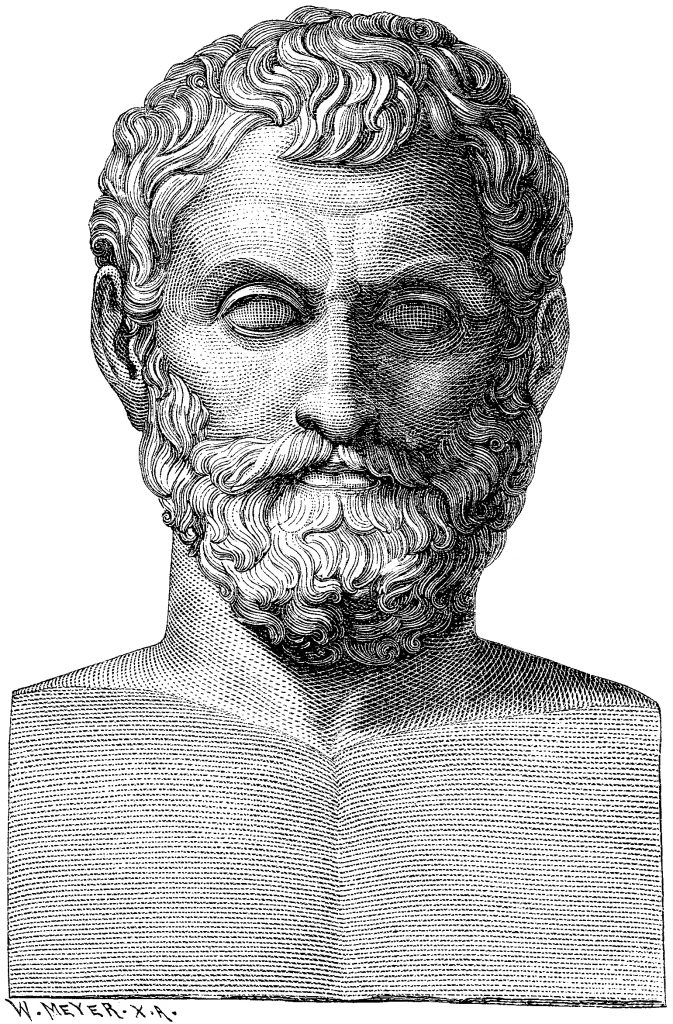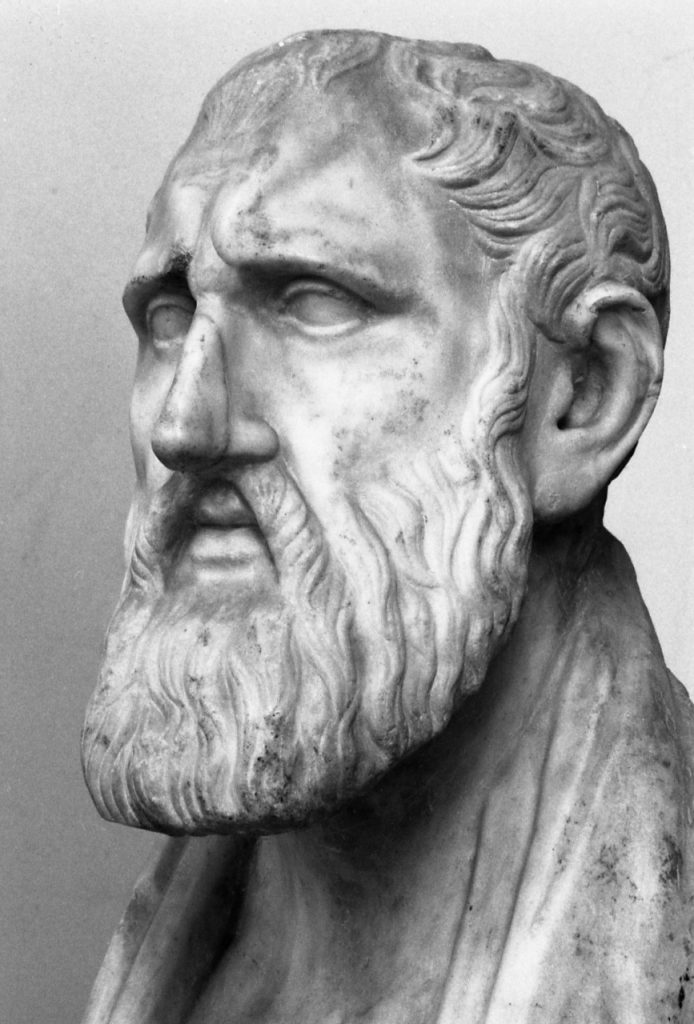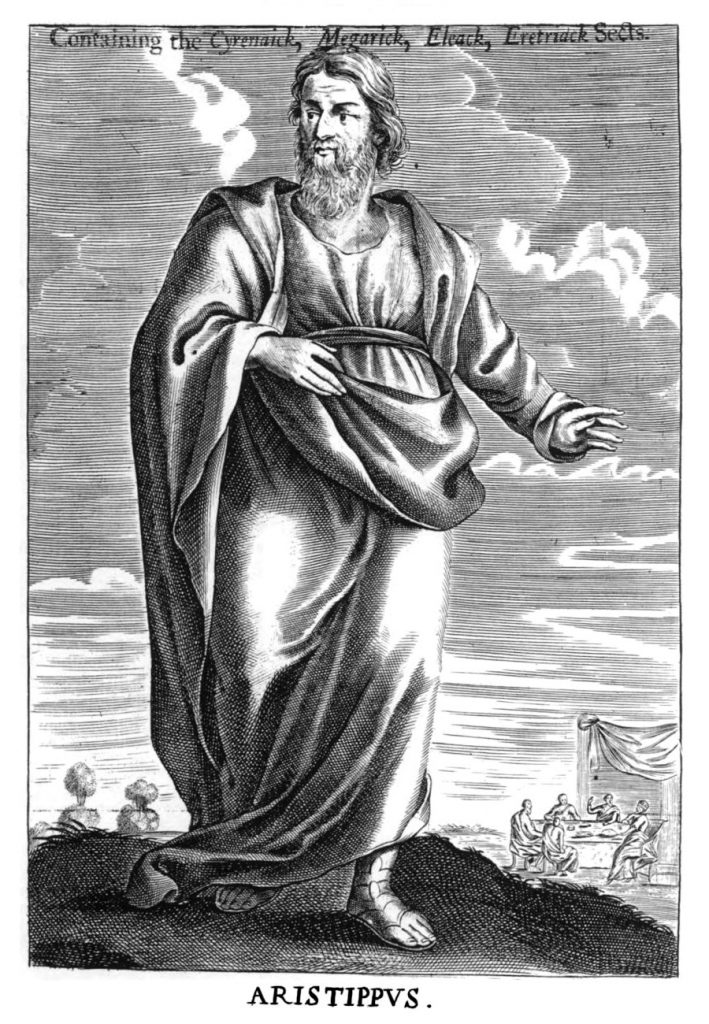
Diogenes Laertius wrote in Greek in Anatolia in the third century CE. The piece of writing that has survived to this day is his Lives of the Eminent Philosophers, which is a compilation of biographies. He described philosophical thought, and gave biographical details, genealogies, and quotes from letters and wills. He gives us anecdotes, and he wrote his own poetry about his subjects. Wikipedia reports that he has been criticized for focusing on trivia while not fully understanding philosophical principles.[1] However, these trivia appealed to me because they seemed to convey the humanity of the characters he wrote about.

For example, the philosopher Chrysippus appears to have been accompanied constantly by a nameless female slave to whom there are only three references, one of which demonstrates part of her character:
At wine-parties he used to behave quietly, though he was unsteady on his legs; which caused the woman-slave to say, “As for Chrysippus, only his legs get tipsy.”
(7; Chrysippus; 183)[2]

Here is an anecdote about the philosopher Thales:
It is said that once, when he was taken out of doors by an old woman in order that he might observe the stars, he fell into a ditch, and his cry for help drew from the old woman the retort, “How can you expect to know all about the heavens, Thales, when you cannot even see what is just before your feet?”
(1; Thales; 34)
Perhaps Thales’ female companion was an astronomer. We do not know these women’s names, but we know they had a sense of humor, and, perhaps, senses of themselves.
Anecdotes like these led me to read further, and to try to identify all the women Diogenes mentioned, which eventually led to this series of blogposts. This first one presents some general points about Diogenes’ writing. In the second I shall explore some of the anecdotes specifically about women, and in the third I will look at what Diogenes has to say about the roles women adopted.
Diogenes often quoted his sources, and consequently we know of the existence of the historian Pamphila, because he used her writings extensively for his descriptions of early philosophers. Wikipedia tells us that all her works have been lost, but that she lived in Epidaurus in the first century CE[3]. She is only known because writers like Diogenes quoted from her works. He often wrote things like: ‘Pamphila in the second book of her Memorabilia . . . ’ Putting these sentences together, it is possible to conclude that Pamphila wrote at least seven books of Commentaries and at least 32 books of Memorabilia. We also get the occasional glimpse of the sorts of things she recorded:
The following riddle of Cleobulus is preserved in Pamphila’s collection:
One sire there is, he has twelve sons, and each of these has twice thirty daughters different in feature; some of the daughters are white, the others again are black; they are immortal, and yet they all die.
And the answer is, “The year.”
(1; Cleobulus; 91)
Pamphila, though, is lost to us, just like Thales’ and Chrysippus’ slaves. Diogenes’ main concern was to write about men. But in focusing on women, we can also learn a lot about the male philosophers. We are told, for example, that Pythagoras ‘got most of his moral doctrines from the Delphic Priestess Themistoclea’ (8; Pythagoras; 169). I wonder what else he learned from her.

Diogenes wrote of Zeno:
He rarely employed men-servants; once or twice indeed he might have a young girl to wait on him in order not to seem a misogynist.
(7; Zeno; 13)
When I first read this it struck me that I could not remember another use of the word ‘misogyny’ in the classics. I searched in Perseus and found only one mention of the word, and that in a secondary source. Whether there was a concept of misogyny in ancient times may be questionable. However, whether or not it was conceptualized, misogyny existed. Diogenes tells of Periander, who:
in a fit of anger, he killed his wife by throwing a footstool at her, or by a kick, when she was pregnant, having been egged on by the slanderous tales of concubines, whom he afterwards burnt alive.
(I; Periander; 94)
On the other hand, wills and letters can reveal philosophers’ positive attitudes towards the women in their lives. Wills indicate that both male and female slaves were often freed on the deaths of their masters. Epicurus provided for his friend Metrodorus’ daughter in his will. This anecdote about Stilpo reveals that he regarded his daughter as an individual:
He married a wife, and had a mistress named Nicarete, as Onetor has somewhere stated. He had a profligate daughter, who was married to his friend Simmias of Syracuse. And, as she would not live by rule, someone told Stilpo that she was a disgrace to him. To this he replied, “Not so, any more than I am an honour to her.
(2; Stilpo; 113).

The philosopher Aristippus seems to have respected his daughter, for Diogenes said he trained her and she became part of the Cyrenaic School of Philosophy. A genealogy shows how learning was passed down, in this case, through a woman:
The disciples of Aristippus were his daughter Arete, Aethiops of Ptolemais, and Antipater of Cyrene. The pupil of Arete was Aristippus, who went by the name of mother-taught, and his pupil was Theodorus, known as the atheist, subsequently as “god.”
(2; Aristippus; 113).
Their treatment of women gives us some insight into the characters of these male philosophers. Unfortunately, Diogenes only includes one woman philosopher in his collection, which describes 81 men. The woman is Hipparchia, a Cynic philosopher who was evidently part of a community of philosophers. She was sister to Metrocles and was married to Crates. Diogenes wrote, tantalizingly:
In the home of Crates Alexander is said to have lodged, as Philip once lived in Hipparchia’s.
(6; Crates; 88)
Is this Alexander the Great and Philip of Macedon? If so, Hipparchia was a hostess to a king, and must have been in esteemed company. Certainly, Hipparchia was said to be from Macedonia. Part of Diogenes’ account of Hipparchia actually concerns Crates.

It is probably worth repeating everything he said about Hipparchia:
Hipparchia too, sister of Metrocles, was captured by their doctrines [those of Metrocles and his associates]. Both of them were born at Maroneia.
She fell in love with the discourses and the life of Crates, and would not pay attention to any of her suitors, their wealth, their high birth or their beauty. But to her Crates was everything. She used even to threaten her parents she would make away with herself, unless she were given in marriage to him. Crates therefore was implored by her parents to dissuade the girl, and did all he could, and at last, failing to persuade her, got up, took off his clothes before her face and said, “This is the bridegroom, here are his possessions ; make your choice accordingly; for you will be no helpmeet of mine, unless you share my pursuits.”
The girl chose and, adopting the same dress, went about with her husband and lived with him in public and went out to dinners with him. Accordingly she appeared at the banquet given by Lysimachus, and there put down Theodorus, known as the atheist, by means of the following sophism. Any action which would not be called wrong if done by Theodorus, would not be called wrong if done by Hipparchia. Now Theodorus does no wrong when he strikes himself: therefore neither does Hipparchia do wrong when she strikes Theodorus. He had no reply wherewith to meet the argument, but tried to strip her of her cloak. But Hipparchia showed no sign of alarm or of the perturbation natural in a woman. And when he said to her:
“Is this she who quitting woof and warp and comb and loom?”
she replied, “It is I, Theodorus, — but do you suppose that I have been ill advised about myself, if instead of wasting further time upon the loom I spent it in education?” These tales and countless others are told of the female philosopher.
(6; Hipparchia; 96ff.).
Hipparchia, then, had ideas of her own about how she wanted to live, and was able to follow them. She was a cross-dresser (and not the only one we will meet); she rejected women’s traditional occupations and chose to educate herself. Diogenes tells us that there are many anecdotes about her, and more are included in her Wikipedia article, but sadly, most have been lost.
A study of Diogenes Laertius, then, is revealing not only of characteristics of male philosophers, but also of the conduct of women who made their own choices about their education and the ways they wanted to live. We get tantalizing glimpses of women who had minds of their own and senses of humor. In the next blogpost I shall retell some of the anecdotes of other women which were not lost, because Diogenes Laertius recorded them.
Next posts in this series: part 2 | part 3
Notes
[1] Wikipedia article “Diogenes Laërtius,” accessed September 2021.
[2] Diogenes Laertius Lives of the Eminent Philosophers. Translated by Robert Drew Hicks. 2011. New York.
This translation is also available on Perseus (from the edition of 1972. Cambridge, MA. first published 1925):
http://www.perseus.tufts.edu/hopper/text?doc=Perseus%3Atext%3A1999.01.0258
The format I shall use for referencing is:
‘(book number; philosopher’s name; paragraph number)’
[3] Wikipedia article “Pamphile of Epidaurus”, accessed September 2021.
Image credits
Diogenes Laertius. Engraving, illustration to 1688 edition of The Lives, Opinions, and Remarkable Sayings of the Most Famous Ancient Philosophers
Public domain, via Wikimedia Commons
Carlo and Filippo Albacini: Bust of Chrysippus
Creative Commons CC by NC, via National Galleries Scotland
Wilhelm Meyer. 1875. Illustration to “Illustrerad verldshistoria utgifven av E. Wallis. volume I”: Thales
Public domain, via Wikimedia Commons
Paolo Monti (photo). 1969. Sculpture of Zeno. Naples.
Creative Commons Attribution-Share Alike 4.0 International license, via Wikimedia Commons
Aristippus, Illustration from Thomas Stanley 1655. History of Philosophy
Public domain, via Wikimedia Commons
Crates and Hipparchia. Wall painting, Villa Farnesina. c 1st century CE.
Public domain, via Wikimedia Commons
Images accessed September 2021.
___
Anne Spendiff is a member of Kosmos Society.